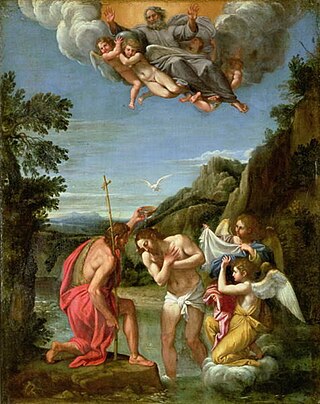
Adoptionism, also called dynamic monarchianism, is an early Christian nontrinitarian theological doctrine, subsequently revived in various forms, which holds that Jesus was adopted as the Son of God at his baptism, his resurrection, or his ascension. How common adoptionist views were among early Christians is debated, but it appears to have been most popular in the first, second, and third centuries. Some scholars see adoptionism as the belief of the earliest followers of Jesus, based on the epistles of Paul and other early literature. However, adoptionist views sharply declined in prominence in the fourth and fifth centuries, as Church leaders condemned it as a heresy.
Gospel originally meant the Christian message, but in the 2nd century it came to be used also for the books in which the message was reported. In this sense a gospel can be defined as a loose-knit, episodic narrative of the words and deeds of Jesus, culminating in his trial and death and concluding with various reports of his post-resurrection appearances. Modern biblical scholars are cautious of relying on the gospels uncritically, but nevertheless, they provide a good idea of the public career of Jesus, and critical study can attempt to distinguish the original ideas of Jesus from those of the later Christian authors.
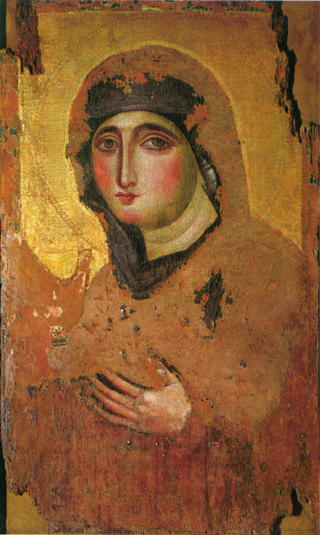
Mary was a first-century Jewish woman of Nazareth, the wife of Joseph and the mother of Jesus. She is a central figure of Christianity, venerated under various titles such as virgin or queen, many of them mentioned in the Litany of Loreto. The Eastern and Oriental Orthodox, Church of the East, Catholic, Anglican, and Lutheran churches believe that Mary, as mother of Jesus, is the Mother of God. Other Protestant views on Mary vary, with some holding her to have lesser status.

According to apocrypha, as well as Christian and Islamic tradition, Saint Anne was the mother of Mary, the wife of Joachim and the maternal grandmother of Jesus. Mary's mother is not named in the Bible's canonical gospels. In writing, Anne's name and that of her husband Joachim come only from New Testament apocrypha, of which the Gospel of James seems to be the earliest that mentions them. The mother of Mary is mentioned but not named in the Quran.

The virgin birth of Jesus is the Christian and Islamic doctrine that Jesus was conceived by his mother, Mary, through the power of the Holy Spirit and without sexual intercourse. Christians regard the doctrine as an explanation of the mixture of the human and divine natures of Jesus. The Eastern Orthodox Churches accept the doctrine as authoritative by reason of its inclusion in the Nicene Creed, and the Catholic Church holds it authoritative for faith through the Apostles' Creed as well as the Nicene. Nevertheless, there are many contemporary churches in which it is considered orthodox to accept the virgin birth but not heretical to deny it.

The nativity of Jesus, nativity of Christ, birth of Jesus or birth of Christ is documented in the biblical gospels of Luke and Matthew. The two accounts agree that Jesus was born in Bethlehem, Judaea, that his mother, Mary, was engaged to a man named Joseph, who was descended from King David and was not his biological father, and that his birth was caused by divine intervention. Some scholars do not see the two canonical gospel nativity stories as historically factual since they present clashing accounts and irreconcilable genealogies. The secular history of the time does not synchronize with the narratives of the birth and early childhood of Jesus in the two gospels. Some view the question of historicity as secondary, given that gospels were primarily written as theological documents rather than chronological timelines.

The brothers of Jesus or the adelphoi are named in the New Testament as James, Joses, Simon, Jude, and unnamed sisters are mentioned in Mark and Matthew. They may have been: (1) the sons of Mary, the mother of Jesus, and Joseph, (2) sons of Mary the wife of Cleophas and sister of Mary, the mother of Jesus; or (3) sons of Joseph by a former marriage. While option 1 is described as the "most natural inference" from the New Testament, those who uphold the perpetual virginity of Mary reject the idea of biological brethren and maintain that the brothers and sisters were either cousins of Jesus or children of Joseph from a previous marriage. The Lutheran Churches have accepted both option 2 and option 3 as being valid explanations for the doctrine of the perpetual virginity of Mary.
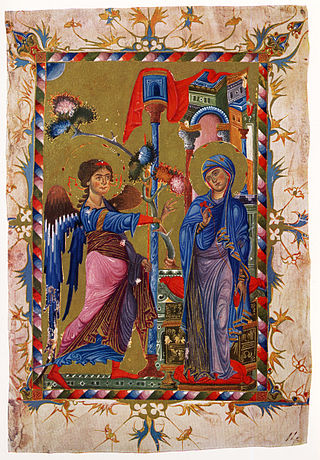
The Annunciation is, according to the Gospel of Luke, the announcement by the archangel Gabriel to Mary that she would conceive and bear a son through a virgin birth and become the mother of Jesus Christ, the Christian Messiah and Son of God, marking the Incarnation. Gabriel told Mary to name her son Jesus.
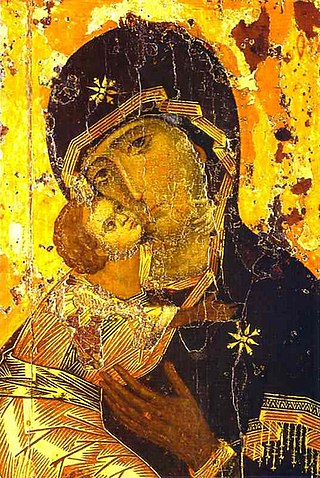
The perpetual virginity of Mary is a Christian doctrine that Mary, the mother of Jesus, was a virgin "before, during and after" the birth of Christ. In Western Christianity, the Catholic Church adheres to the doctrine, as do some Lutherans, Anglicans, Reformed, and other Protestants. The Oriental Orthodox Churches also adhere to this doctrine as part of their ongoing tradition, and Eastern Orthodox churches recognize Mary as Aeiparthenos, meaning "ever-virgin". It is one of the four Marian dogmas of the Catholic Church. Most modern nonconformist Protestants reject the doctrine.

The Syriac Infancy Gospel, also known as the Arabic Infancy Gospel, is a New Testament apocryphal writing concerning the infancy of Jesus. It may have been compiled as early as the sixth century, and was partly based on the Infancy Gospel of Thomas, the Gospel of James, and the Gospel of Pseudo-Matthew, though much of it is also based on oral tradition. The only two surviving manuscripts date from 1299 AD and the 15th/16th century in Arabic. They were copied in the area of northern Iraq and show influence from the Quran.

The New Testament apocrypha are a number of writings by early Christians that give accounts of Jesus and his teachings, the nature of God, or the teachings of his apostles and of their lives. Some of these writings were cited as scripture by early Christians, but since the fifth century a widespread consensus has emerged limiting the New Testament to the 27 books of the modern canon. Roman Catholic, Eastern Orthodox, and Protestant churches generally do not view the New Testament apocrypha as part of the Bible.

Jesus, also referred to as Jesus Christ, Jesus of Nazareth, and many other names and titles, was a first-century Jewish preacher and religious leader. He is the central figure of Christianity, the world's largest religion. Most Christians believe Jesus to be the incarnation of God the Son and the awaited messiah, the Christ that is prophesied in the Old Testament.

The study of Jesus in comparative mythology is the examination of the narratives of the life of Jesus in the Christian gospels, traditions and theology, as they relate to Christianity and other religions. Although the vast majority of New Testament scholars and historians of the ancient Near East agree that Jesus existed as a historical figure, most secular historians also agree that the gospels contain large quantities of ahistorical legendary details mixed in with historical information about Jesus's life. The Synoptic Gospels of Mark, Matthew, and Luke are heavily shaped by Jewish tradition, with the Gospel of Matthew deliberately portraying Jesus as a "new Moses". Although it is highly unlikely that the authors of the Synoptic Gospels directly based any of their accounts on pagan mythology, it is possible that they may have subtly shaped their accounts of Jesus's healing miracles to resemble familiar Greek stories about miracles associated with Asclepius, the god of healing and medicine. The birth narratives of Matthew and Luke are usually seen by secular historians as legends designed to fulfill Jewish expectations about the Messiah.

The Latin Gospel of Pseudo-Matthew is a part of the New Testament apocrypha. In antiquity, the text was called The Book About the Origin of the Blessed Mary and the Childhood of the Savior. Pseudo-Matthew is one of a genre of "Infancy gospels" that seek to fill out the details of the life of Jesus of Nazareth up to the age of 12, which are briefly given in the Gospels of Matthew and Luke. In the West, it was the dominant source for pictorial cycles of the Life of Mary, especially before the Late Middle Ages.
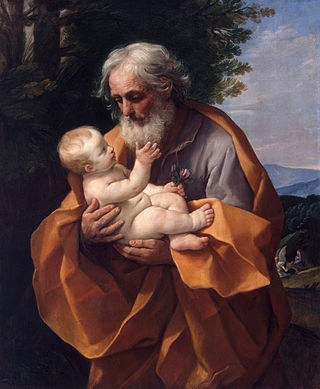
Matthew 1:25 is the twenty-fifth and last verse of the first chapter of the Gospel of Matthew in the New Testament. Joseph has awakened from a dream in which an angel gave him instructions about the birth of Jesus. He has taken Mary into his home, completing their marriage, and this verse explains what occurs once the couple is united.
The Antidicomarians or Antidicomarianites, also called Dimoerites, were a Christian sect active from the 3rd to the 5th century. Their name was invented by an opponent, Epiphanius of Salamis, who described them as heretical in his Panarion. The existence of the Antidicomarians as an organized sect may be doubted, as it is attested only in Epiphanius, but the doctrines he attributes to them were certainly matters of live debate in the late 4th century.
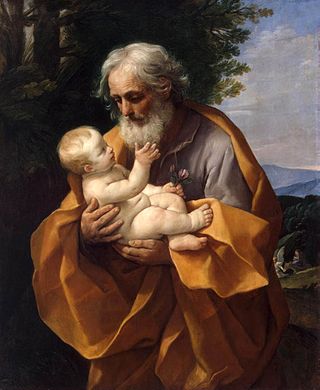
Joseph was a 1st-century Jewish man of Nazareth who, according to the canonical Gospels, was married to Mary, the mother of Jesus, and was the legal father of Jesus.

Oral gospel traditions is the hypothetical first stage in the formation of the written gospels as information was passed by word of mouth. These oral traditions included different types of stories about Jesus. For example, people told anecdotes about Jesus healing the sick and debating with his opponents. The traditions also included sayings attributed to Jesus, such as parables and teachings on various subjects which, along with other sayings, formed the oral gospel tradition. The supposition of such traditions have been the focus of scholars such as Bart Ehrman, James Dunn, and Richard Bauckham, although each scholar varies widely in his conclusions, with Ehrman and Bauckham publicly debating on the subject.

Infancy gospels are a genre of religious texts that arose in the 2nd century. They are part of New Testament apocrypha, and provide accounts of the birth and early life of Jesus. The texts are of various and uncertain origin, and are generally non-canonical in major modern branches of Christianity. They include the Gospel of James, which introduces the concept of the Perpetual Virginity of Mary, and the Infancy Gospel of Thomas, both of which cover many miraculous incidents from the life of Mary and the childhood of Jesus that are not included in the canonical gospels. Although the Life of John the Baptist focuses on John the Baptist rather than Jesus or his immediate family, it is also included in the genre as its events would be contemporary with Jesus's early life.

The Armenian Infancy Gospel is a sixth-century apocryphal infancy gospel based on an older Syriac version which no longer exists. The gospel has two versions, a longer one and a shorter one. The text includes stories about Virgin Mary's life, her marriage to Joseph, her miraculous birth to Jesus, Jesus's childhood and his later life like the other infancy gospels but with some distinct features.

















